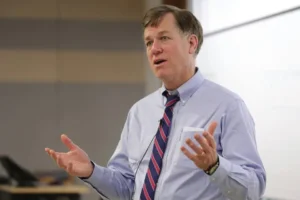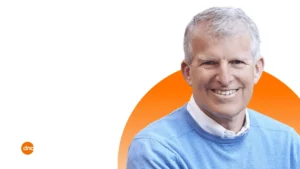From Cubicles to Clouds: Building the Right Connections with Your Team
Does proximity really matter when it comes to performance? Michael Arena, faculty member at the University of Pennsylvania, is no longer convinced it does.
In this episode discover the latest insights and thinking around what connections teams need to make to spur innovation, build collegial bonds and boost productivity regardless of where they work. Hear why Michael and Glenn both urge leaders to be more intentional when it comes to how they connect their teams, with a key focus on creating more informal moments for employees to interact. Learn how remote managers can make the most of virtual working environments, and how leaders can deliver more effective messages to their teams both on and off the screen.
Episode Guest

Michael Arena is the Chief Science Officer and Co-founder of Syndezos.
He is a faculty member in Penn’s Master of Science in Organizational Dynamics program and acts as a design thinking coach within the Stanford School. Michael is the author of the book: Adaptive Space: How GM and Other Companies are Positively Disrupting Themselves and Transforming into Agile Organizations.
He was the Chief Talent Office for General Motors Corporation where he launched GM2020, a grassroots initiative that was featured in Fast Company and Fortune MAgazine. Michael lives in Detroit with his wife and two daughters.
You can follow Michael and connect with him via Connected Commons or LinkedIn.
Episode Guest

Glenn Carroll is The Adams Distinguished Professor of Management at the Stanford School of Business, teaching both executives and MBA students.
He has taught in many programs, including most prominently several high-level custom executive education programs for global Fortune 50 companies, including the General Motors’ “Transformational Leadership Program.”
Glenn is the author of several books including: Making Great Strategy, Culture and Demography in Organizations and Logics of Organization Theory. He grew up in Indiana and has visited many universities and institutes across the world including the Max Planck Institute for Human Development in Berlin, the Hong Kong University of Science and Technology and the National University of Singapore.
You can connect with Glenn via his Stanford faculty bio.
Podcast Host

Stuart Paap is laser focused on helping more people unlock brilliant and bold ideas. He works with pioneering biotechs and healthcare companies, and regularly presents at universities and tech incubators like the Harvard Innovation Lab. He’s also a former stand-up comedian and is a yellow belt in Judo, which strikes fear into no one.
Podcast Timeline
- 03:17 - Why Chance Encounters Spark Innovation
- 04:38 - Going Beyond the Blanket Work From Home Policies
- 05:47 - Why the Water Cooler Really Matters
- 06:43 - The Difference Between Informal and Formal Meetings
- 10:15 - Virtual vs Face-to-Face Bonds
- 13:53 - How to Find Out What Works for Your Team
- 19:50 - Constructive Challenging: Encouraging Healthy Debate
- 39:41 - Four Elements to Communicating Strategy

Podcast Transcription
Stuart Paap:
00:00
Welcome to Stand Up to Stand Out the podcast. I’m your host, Stuart Paap. And for the last decade plus I’ve been working with innovators and leaders inspire others to take action. My goal with this podcast is to give you practical, tactical advice that you can use now. Whether you’re scaling a company, leading a new team, or advocating for meaningful change, this show is designed to help you make a positive impact with those who count. So let’s learn together and have some fun along the way. Let’s get to it.
I am absolutely delighted to have two guests with me today, so it is going to be twice the fun. So first I have Glenn R. Carroll. He’s a professor of organizational behavior at Stanford Graduate School of Business. He runs a transformational leadership program with Fortune 500 companies, and most recently the co-author of Making Great Strategy. I also have Michael Arena, the author of a groundbreaking research on adaptive space, beautiful graphics by the way, which won the 2017 Walker Prize from people in strategy. His work has been cited in the Wall Street Journal, chief Executive Magazine, Harvard Business Review. And Arena teaches in Penn’s Masters in Organizational Dynamics program and acts as a design thinking coach at Stanford Design School.
Welcome, Glenn. Welcome, Michael.
Glenn Carroll:
01:25
Thank you, Stuart. Great to be here.
Stuart Paap:
01:28
Recently, you teamed up on a podcast episode that I recommend everyone listen to, and I’ll include a link in this podcast. So the title was Ties That Bind, Why Remote Teams Need the Right Connection. And immediately I read that title, I knew I had to listen to it and I’m thrilled to have you both today. What does it mean to have the right connection? And we’ll start with you, Michael.
Michael Arena:
01:54
Glenn and I have been talking connections for years and studying networks and how connections show up in organizations, and I would say people have been loosely interested in that topic over time. And then this thing called COVID hit and all of a sudden our connections started to matter at a whole different level. And almost immediately, we were surprised, positively surprised like, hey, we’re able to maintain certain types of connections and be productive in this remote environment. And yet there were other types of connections that dropped off the planet from the very beginning.
And just to put that in context, our close ties, our bonding relationships within our teams generally, we were able to translate that rather well, quite well over into a remote environment. But our bridging connections generally, or some people call them weak ties or there were some overlap with weak ties, started to drop off the planet. In one study we saw a 30% decline in as little as two months, which are those connections across teams or across groups. And I think that led us to… I don’t know, Glen, how we got started on this, but I think that led us to a conversation around, hey, productivity looks fine at least in the short term here, but what about innovation and what about creativity, which we know come from those later types of connections?
Stuart Paap:
01:36
Why Chance Encounters Spark Innovation
Glenn Carroll:
03:17
Yeah, one of the things we know about innovation is it often comes about through chance encounters where you meet somebody at the water cooler and you make some comment and they say, “I never thought about that. That reminds me of X.” And these are casual chance encounters that occur in the normal workday. And when you go to online devices like Zoom, everything becomes much more intentional and purposeful. And so even when you try to do casual encounters, they have to stifle field them. So what we were worried about was that the chance elements that sometimes, not always, but sometimes induced ideas for innovation, that those might get lost in the remote world even though productivity seemed to be going up.
Stuart Paap:
04:07
One of the things I heard from my clients is that the pandemic shifted the world into very black and white. I’m either in a Zoom meeting or I’m not and I’m with my kids or doing something else, but what was missing was the gray area, meeting somebody at the water cooler, at the elevator, having coffee with somebody. And they missed that because it was sort of the cement that bonded the bricks together. How can we bring that back so that we foster innovation?
Going Beyond the Blanket Work From Home Policies
Glenn Carroll:
03:17
Michael has a lot of specific ideas and things he implemented when he was at at AWS and his scene in other companies, but I think part of our reason to write this article was reaction to blanket policies. The companies would come back and say, “Well, we want people to be in the office three days a week, Monday, Tuesday, and Wednesday and then the rest of the time you can be remote.” And that just seemed artificial to us and not fit to purpose. And so I’d say one of the main messages in our article was, you ought to think about, be intentional and think about what the purpose of your team is and what the goal is, what the purpose of a meeting’s going to be, and then decide, can we do it online and is it still going to be as effective as it would be or should we do it in person, and if so, what’s the best way to do it in person?
And then, of course, there are other devices like Slack and like that are intended to present a relaxed online environment. But again, I think those are often more artificial and stifled than a real lunchtime conversation, let’s say.
Why the Water Cooler Really Matters
Michael Arena:
05:47
I remember early days of the pandemic where this really started to come up was hey, we can be productive in this environment but can we continue to innovate on behalf of the customer for the customer in the long haul? And there were multiple conversations happening across all kinds of organizations to the effect of, remember what used to happen between meetings? You would either sit in your chair and talk to somebody offline, off script, off agenda about something they just said in that meeting or you would walk with them, a hallway conversation from that meeting to the next. And that’s where the real innovation happens. I know we oftentimes say it’s the proverbial water cooler. Rarely is. It’s most often something was seated in this meeting. And it’s a little bit to your question, Stuart, it was off agenda versus on script. And that’s what we’ve lost if we’re not intentional.
The Difference Between Informal and Formal Meetings
Michael Arena:
06:43
And more recent study, this isn’t in the article, but a more recent study we’ve been looking at is formal interactions. We can look at all those different things on passive channels, Zoom or Microsoft Viva, Microsoft Teams if you will, we can look at passive interactions and we can see those things that were scheduled and those things that weren’t. And what we are finding is the formal things, like management reviews, team meetings, town halls, those formal things, those things that are scheduled and planned for and are traditional meetings where we are always with an agenda and always on, those actually translate quite well even in a remote environment. When you compare people remotely working versus those in the office, which we’ve been able to do with some recent data sets, you don’t see a whole lot of difference in the network on formal interactions. Where you see a radical change…
And in fact if you’re remote you might actually see a small increase in formal interactions, if anything. But where you see a big difference is on informal connections. So that’s the hallway conversation, after a meeting. That’s the, I need to figure out how I’m going to influence somebody to make a different decision and this isn’t a person I interact with every day. There are these discovery connections that are so critical to innovation. And what we saw was those are dropping off anywhere from 25 to 30% for those people who are working exclusively remotely or predominantly remotely. So that’s a long-winded response.
To get to the answer to your question, one of the things we think we can do, but we’re still in the early stages of this, is make those informal interactions more formal. What can you do to create a formal interaction with that hallway conversation? Or what can you do to really force some of these informal things like who you go to for career advice or who do you go to for new ideas? How can you formalize that in such a way that it’s not just getting lost for those people who are working remotely? Sometimes that could be as simple as we’re going to take 10 minutes at the end of the meeting and go completely off script and just brainstorm on anything that you can think of that came up in that meeting. And you just basically approximate what’s happening after the meeting in a physical environment. And those are the things that we think you can get more intentional about in order to really amp up the informal interactions.
Stuart Paap:
9:13
So if I understand correctly, we are pretty good at doing work that’s “on the page” in these remote meetings, but it’s that off the cuff, finding organic interactions, mentorship opportunities, career growth, bonding friendships that we can start designing into formal meetings for people who are remote. So the first 10 minutes, the last 10 minutes. Would that be a step in the right direction at least according to what you’re seeing for preliminary research or the indications?
Glenn Carroll:
9:47
Yeah. And I think even something… Sometimes in meetings, people will disable chat, let’s say in Zoom. Well, letting chat flourish is actually a way to let people continue these normally informal conversations and letting them have access to the chat notes afterwards. And it may appear to be a distraction of sorts, but it’s actually conveying information and people, they’re not going to write a message if it’s not meaningful to them.
Virtual vs Face-to-Face Bonds
Stuart Paap:
10:15
Right. I remember in my career years and years ago, I went through a training program and it was a week with a whole bunch of us in a different part of the country and we really bonded. We were all together for a week pretty much night and day and then everyone flew back to their part of the country. And I haven’t even talked to many of those people or seen them in many, many years, but that connection is still there and I think people can relate to this intensive in-person where you get a chance to have all the spectrum of interactions with someone in a short time. What are some ideas for the future of work?
Michael Arena:
10:52
I love that you landed on ideas. I won’t speak for Glen, but I think I can. The real answer to your question is it depends on the context, it depends on the company, it depends on what you’re trying to do. It depends on a bunch… It’s always contextual. And it’s hard to say absolutely this is how networks form because there are so many other aspects to the way this really happens.
I think a couple of thoughts, and Glen knows much about this as well, so please add Glen much more I should say. So please add. One is it’s not difficult to reformat these, what we call dormant ties in social science, like these bridge connections, people who you were connected to from a different group who you bur built trust with. Glenn and I don’t interact with each other very often, but it’s not hard for me to pick up the phone and just call Glenn and within five minutes we’re back in the same flow of the last conversation we had, even if it shows up as a dormant tie in my network. That’s not the real risk. The real risk is the risk of me forming new ties with people like Glenn so that I can continue to learn and continue to discover and innovate.
And that’s where we believe, I believe that coming back together from time to time to build that at least personal trust is important. And how often you do that, when you do that, in what context, I think all those things, they’re all dependent upon what you’re trying to accomplish and so on.
Glenn Carroll:
12:27
To reinforce that, if I remember correctly, Michael, you told me you saw in some of the data you have that during the pandemic that groups that were already established were able to continue pretty efficiently and effectively online. But the real trouble was with the newcomers who had trouble onboarding and socialized and feel like they were really a part of the group. And that took a lot longer because they didn’t have this intensive initial component that we often have in starting a job.
Michael Arena:
12:58
Yeah, that’s exactly right. And that’s where some of the things around even productivity had begun to break down a little bit in an exclusively remote environment because you have so much newness, you don’t have quite the level of bonding or cohesion because you can earn trust remotely. It is true, but it takes many more iterations. And none of us have more time these days, and it’s that part that’s harder to do. One of the things you can do, we believe you can do is you can fast track that. You can accelerate that process by getting together periodically and you get the face-to-face time. And as social creatures, we tend to earn trust more quickly face-to-face as opposed to virtually.
How to Find Out What Works for Your Team
Stuart Paap:
13:53
What’s a process that someone could have if they’re running a remote teams, like a lot of my clients are, or standing up a new teams and everyone is all over the globe? What’s a way to approach it from a forward-thinking and a backward looking perspective?
Glenn Carroll:
14:08
Yeah, I think the world we live in now, it’s very hard to determine upfront what you’re going to like and don’t like. You almost have to experience it. So at least my intuition is schedule different things, try them out and then get the reactions to those and then develop a plan based on that. If you do it purely based on preferences without the experiences, maybe you’ll get it right. But I think you’re absolutely right. People don’t know what they want a lot of the times these days. And I think that’s going to amplify, as people start coming back in the office, if being there gets you more face time with the boss, you get a lot of more information, you get involved in new things more easily, you get promoted faster or you get involved in the top projects, then that people are going to see that and say, “Well, I’m missing out by not being in the office.” So it’s going to evolve and I don’t think we know where it’s going to go, but it wouldn’t surprise me if there’s a premium on being back before too long.
Michael Arena:
15:06
Yeah, I would concur with everything Glenn just said. I think it’s about experimentation. This is a new world. We have never been here before. If you were to ask me, could have we been productive in a complete remote environment? I would’ve said pre-pandemic, I would’ve said absolutely not. Everything I ever learned is that proximity matters to performance. Turns out that’s not true. Turns out that proximity is more of a proxy for cohesion. We were measuring the wrong variable, and you can sustain that remotely. But moving forward, I think we got to experiment our way there because we’ve never worked in this kind of an environment.
And I don’t think… Employee listening is important. In corporations, we would describe this attitude or preference from an employee perspective as being the listening system and it’s super important and we absolutely need to listen to what our employees are saying, but many of us, including myself, were walking hypocrites.
I mean, my favorite study was a study where an organization had asked a question, what percent of you or what would you prefer, working remotely or coming back to the office? I think this is the right number, 77% of those human beings said, “I want to continue to work remotely.” Same survey, same human beings, 63% of those same people said… So just do the math in your head. 63% of the total population surveyed said, “I can’t wait to get back in the office to be with my colleagues.”
So it’s a little bit of what you said, Stuart. We don’t really know what we want completely. We definitely want the flexibility and the autonomy and all the benefits of working remotely, but we’re missing some things as well. And to Glen’s point, we’re going to experiment and experience our way to a better future that’s going to get us the win-wins on a boat. There are going to be times to come in the office that are going to be super advantageous and there are plenty of times where we’re going to be more productive heads down remotely.
I was writing all morning. I couldn’t do that in the office. I remember whenever I used to have to write from a job standpoint, I had to schedule time out of the office just to focus and concentrate. And today, I don’t have to schedule that, I just block out my calendar. So I think we’re going to figure out our way there, and it’s going to probably be a better ending point than what the starting point was pre-COVID.
Stuart Paap:
17:29
And both things can be true. One can want to work remotely and want to be with their colleagues. What I think the pandemic has shown us is that bringing back some autonomy is good for workers but it also is good for their families and their caregiving. So can we find a way forward? And it seems like we really can, and we just have to be intentional about it. If your goal is to write a new book, maybe you should stay out for the next three months. And if your goal is to run a new innovation project, maybe you should take over the offices for a month, some version where we’re being really intentional about what’s the outcome of that work over the time.
Michael Arena:
18:10
And I couldn’t agree more, and that should have been true from the beginning, right? That was true even before. It’s a form follows function model. We should first ask our question, what’s the function we’re trying to solve for? Are we trying to discover new ideas? Are we trying to build out those ideas into products or solutions, or are we trying to influence others? And that’s what we did try to articulate in the article, are you ideating? Are you incubating that idea, building on that idea, or are you trying to scale that idea? And each of those functions requires a different form of interaction. That was always true. That was true regardless. It’s just more prevalent now. It’s more noticeable now because you literally have to change environments to make that happen.
Stuart Paap:
18:59
And I could see that really being an accelerant. So if you say to everyone, “Look, we’re in ideation mode, so we’re going to invest and work this way because that’s the phase we’re in.” And then, if that chapter’s over and you’re in incubation mode or execution or scale mode, even signaling that to people with their environment saying, “The reason we’re all working remotely is because now we’re in that phase,” I think that could actually be an accelerant to just be a queue this is the phase we’re in and this is how we’re working.
Glenn Carroll:
19:25
Yeah, that’s right. I mean, I also think, though, it puts more onus on the manager to think about things and set it up in advance. And that could be a challenge in some cases and it creates more overhead and more points of discussion, contention perhaps, but it’s absolutely the right thing to do. I mean it may help you figure out who’s a really good manager and who isn’t as well.
Constructive Challenging: Encouraging Healthy Debate
Stuart Paap:
19:50
I want to pivot to something that’s a theme I saw in both of your excellent books and this is the idea of conflict or challenging, and it’s something that it’s easier to talk about and harder to do. So Glenn, I’m looking at making great strategy and one quick excerpt here that you can both unpack, but we’ll start with you Glenn. So vigorous argument should be encouraged and celebrated provided that people are arguing constructively. So there’s a lot in that sentence. So maybe we could talk about encouraging vigorous arguments and celebrating them, what that looks like in organizations.
Glenn Carroll:
20:27
In our book, we’re talking about arguing about or discussing or debating strategy, what should be the position of the firm going forward in its let’s say product market or service market. And people often wind up thinking that arguments are a bad thing and that the last thing we want to do is have a fight and I can’t believe they were disagreeing. Often they’re disagreeing over facts. And you can clarify what the facts are upfront or there are ways to clarify them. And then you want to have a discussion over what’s the appropriate response to the facts or the things that you think are going to be the facts. And you got to accept that the future’s uncertain. We don’t know. We’re trying to make our best choice and we’re trying to hedge our bets, but everybody has an opinion on that, and it’s worth hearing those and taking them seriously and then coming to a reasonable judgment after that about what’s the best course of action decision.
And people often take those positions very personally and then it becomes you versus someone else, and it’s not about an objective decision about what’s the right thing for us to do collectively. And so we were trying make a case for arguing constructively in the sense that it’s not about the person, it’s not about the facts necessarily if you’ve vetted proper facts, but it’s about what’s the right thing to do in an uncertain world and why or why not would this make sense? And what are the assumptions you’re making in the process? And I think the leaders need to work hard to establish that kind of dialogue system so that people don’t feel threatened by it and that they understand that it’s not to be personalized.
Stuart Paap:
22:15
And picking up that theme, Michael, in your book, you had this idea of the challenger, so you have two parts of your book. Part one, uncovering the power of networks. Part two was opening up adaptive space. But in part one you talk about broker connector, energizer, and then the challenger. Would a challenger occupy that role in this setting or could occupy that role? Or maybe you want to unpack that for the audience and explain the role of a challenger and the value to an organization?
Michael Arena:
22:44
Yeah, I mean, I will start by saying this, if everybody around you is saying yes, yes, yes, go go, you are most certain to fail. I’ll start there. If you don’t have some productive friction in the system, some element of pushback, whatever idea or whatever innovation you’re building, it’s never going to be as big or as bold as it could be or as effective as it could be.
So the challengers, and I talk a lot about this in adaptive space, really play two critical roles. The first thing a challenger does is it looks at the existing orthodox and that person starts to tear it down like, hey, this made us successful, this is what got us here, but this isn’t what’s going… The landscape’s changed around us. We live in a dynamic world and we’re not going to be able to continue to be effective if we stay the course of where we are. So a challenger will first disrupt on the front end to say conventional wisdom is no longer wise, if you will. But a challenger also works at the back end of the innovation process.
I’m going to pick on Glen for a little bit. If I could glen’s one of my challengers. I pick up the call whenever I really want to know, is this idea a good idea? Because I have 10 ideas a day. Most of them are really lousy ideas and I don’t even believe in them by the end of the day. If I believed in it three days in a week, then I want to work on that idea a little bit. And once I start to believe in it and start to stand it up and find a few people who… I talk about finding a friend in the book. A few people that can help me coil it and I got a little bit of ownership with it, then I’ll pick up the phone and I’ll call my grand challengers, Glen’s one, there are others. Glen does something awesome for me. He fool proofs that idea. And it won’t be the same idea by the end because I’m being challenged to think about it from a different perspective, which isn’t my view of the world. And that’s what a challenger does. A challenger adds productive friction to morph an idea so that the idea can actually stand up in the world better, more effectively.
Stuart Paap:
25:01
What I notice is that people tend to assign in group, where everyone’s working for the same company, the personality versus the role they’re playing. And so a way around this could be, one idea to kind of paraphrase you, Michael, is role playing like a red team game where you wore a game and say, “Okay, for the purposes of today, Stuart has 10 ideas. Glen, you will oppose each one of these. Michael you’ll support and then we’ll flip-flop.” So now I’m assigning you more of a role that’s designed to get the best critical thinking, but at the end of the day, we can all go have a beer together because we know that we’re colleagues, we’re supporting each other. And once we agree, I will be there to support the execution of it. And sometimes I feel like people either commingle these or they don’t distinguish that. So I don’t know if there’s a way around it to encourage this spirited constructive debate without diminishing or eroding relationships that are critical in work.
Glenn Carroll:
26:07
Yeah, you’re absolutely right. It becomes personal. So we discussed in our book using something a little less formal than what you’re talking about with the teams, but just appointing someone as a so-called devil’s advocate. So we’re going to discuss whether to move into this product market on day X and we’ll have all the people who are in favor of it lined up with their arguments. But we rather than wait for someone to naturally develop an opposing argument, which then makes it personal because they’re opposing the group, you assign one or someone or a team of people to say, “Okay, we would like you to muster the best set of counter arguments for why we should not do this.” And it’s understood that that’s their job. They may or may not believe those positions, but they’re charged with developing the best argument they can.
And they’re not supposed to take it lightly. They’re supposed to really challenge it. And then you have a group discussion about that where everyone thinks like, “Okay, we’re talking about ideas and possibilities. We’re not talking about personal preferences or wishes or beliefs or our own interests. And we can have a discussion on that at the end of the day, come away still being good friends and colleagues and not have a personal issue with somebody who took an opposing sign.”
If you just let it occur naturally, there’s always the guy who’s there, he said doesn’t like anything and they say, “Oh, there goes Stewart again.” And everybody rolls their eyes and they don’t listen. And that’s not what you want. You want them to listen, you want them to take it seriously and you want the best ideas to win.
Michael Arena:
27:49
There are a couple things in there and there’s one other really effective way. I’ve seen this done inside a corporations. Actually, at Amazon to be more specific. But one of the things that Glenn said that I think we just need to really emphasize is those counter arguments should never be about the inventor, only the idea, or never be about the creator, the strategist, but only the strategy in Glenn’s context. And if you can do that, if you can separate those two and people start to recognize you’re not critiquing me, you’re critiquing an idea. And really, if you’re a fragile individual and you can’t separate those two, that could be a problem for you. But I think it’s really clear that you should be pulling them apart, the idea. I shouldn’t say, “Glen, when you do this,” but I might counter argue Glen’s hypothesis or premise if you will.
The other way I’ve seen this done really well is put it back on the inventor themselves preemptively. So one of the things that Amazon does really well is everything’s written in a document. So if you got a new idea, you write it up. And at the end of a document, there are pre-structured, hotly debated questions or hotly debated topics. And rather than waiting for someone else to show up, if there are things that I just am not certain about or I think others are going to be uncertain about, I’ll just raise them. If I’m writing that doc, I’ll just raise them as issues. And then what happens is mostly people will agree with the things that you’ve written prior to that and focus most of the energy, productive friction energy, on solving for those two hotly debated topics. And rather than talking about 30 things, you spend your time perfecting and elevating two things. And all of a sudden, it’s not at that point about the inventor at all anymore, the individual at all. It’s about how are we going to make this better together at the end of the day.
And if you don’t have that tension, I oftentimes would say… I think I even said this in [inaudible 00:29:50] space, you can’t have a breakthrough unless there’s something to break through. You’ve got to break through some conventional wisdom and you got to push that boundary. And that’s, again, what the devil devil’s advocate or the productive friction really does. It helps to shatter the original paradigm to think about it differently and elevate it.
Stuart Paap:
30:07
I’d like to ask about… I’m imagining a room where someone’s presenting a new idea at some fast moving tech company. I’ve also heard if there’s 10 people in a room, let’s just say that two or three of them are extroverts and they may dominate and influence the tenor of the meeting. How does one encourage that diversity of thought in those critical meetings and make sure that just not a few people sway the meeting?
Glenn Carroll:
30:30
The psychologists have a technique they call nominal group technique, or NGT, which requires some setup, but it’s very effective. And basically what you do is you circulate the questions or the issues that you’re going to discuss in advance and you ask for some preliminary advice or responses in advance. And then the meeting organizer collates those, collects them and distributes them before the meeting often without attribution to who said what. You say, “Okay, we said we’re going to discuss moving into this product market and there are 10 of you, six people favorite, four people don’t. Here are the reasons why.” And they get all that information in advance. And then when you come in the meeting, I mean, it has the effect, it’s very efficient because you’re not wasting your time just explaining positions. You’re actually now going to be able to have an exchange to debate the viability of them and you can get down to business a lot quicker. And it’s kind of depersonalized it. And it’s also everybody feels the obligation to respond and the organizers should follow up if they don’t. And you get all that input. And so even if they don’t talk much into meeting, they’ve had input into that. And so there are a lot of studies in psychology that show this is actually a very effective way to run meetings where you try to make a decision.
Michael Arena:
31:48
I’ve actually seen that automated and it’s by far the most effective decision making process I’ve ever been part of, where exactly that decision is being presented. Five independent people review it. I would add one notion to the end, maybe you said this, Glen, but they all decide thumbs up or thumbs down. They add commentary. People don’t see who was thumbs up or thumbs down until they’ve submitted their own. So it’s locked in at that stage. And then the discussion is, so Glenn, these were your points. And then the facilitator brokers the dialogue. And if everyone’s in alignment, pulling those voices in are a less meaningful or less needed, where if there’s one or two people that are standing on the edge of a decision or have a contrarian view of something, they’re pulled in.
And I’ve seen it flip. If there were six people and one person was sitting out, it’s like the 12 Angry Men movie. I’ve seen it flip in the other direction if properly facilitated because somebody had some really substantial things that everybody else just looked past for whatever reason. So if it’s a critical business decision, it’s worth taking that time and doing something like that.
I also would say you’re not always afforded the opportunity of using nominal group process in advance. Great leaders know how to make this happen on their own. I worked with a phenomenal leader. I won’t name by name right now, but in this particular case, at the end of a meeting, this person would call out the people who haven’t spoken and say, “Jim, you’ve been silent. Or Jenny, I haven’t really heard your point of view. I know you have a point of view because we talked about this before.” And a great leader will listen, listen, listen, pull in different thoughts and then at some point, even help them make the decision at the end after that’s all been considered. And I think leadership can really help to ensure that there’s a balance of perspectives.
Stuart Paap:
33:50
I love that. So I hear really planning, designing it into the meeting, doing the work, getting the ideas on the page, using anonymous or blind ways to extract those decisions and then being proactive and pulling people in. Those all seem very doable and action-oriented ways to make sure you’re getting all the voices out. Did I miss anything with those two?
Glenn Carroll:
34:17
I mean, Michael said something I think it’s important to note, it also depends on the kind of decision you’re making. And I think it is Jeff Bezos has quoted as talking about really irreversible decisions versus those that are reversible. And so some of them are so big you just came back at them. And for those, you really want to do as much pre-planning and this deliberative [inaudible 00:34:38]. If it’s something that’s a minor decision and if you make a mistake, you can go back and reverse it, it may not be worth all this effort.
Stuart Paap:
34:53
Could you distinguish between broker and connector and then explain energizer and challenger just so we can understand?
Michael Arena:
35:01
Yeah, absolutely. These are four roles. You’re on a continuum between a broker and a connector. You’re in the same network. You’re not going to be both of those. In a different network, you could be. We talked a little bit about this at the beginning of the podcast. That’s basically your network position. So that is you’re more central to a given team. A better way of describing a connector is a central connector, which means they’re central to any given place in the network, any given team in the network, they have a lot of redundancy around them.
So in other words, I’ll pick on Glenn a little bit more. Glenn is a central connector at Stanford Business School because he is super connected to everybody there and other people are connected to each other. And most likely, he may argue with me about this, most likely, because that’s what he does, he’s in the center of that network just as I was when I was at Amazon or General Motors with my team.
A broker is someone who bridges across groups. So a broker in say, take it to General Motors context for a moment, would be a person who set across four or five different teams or two or three different functions. They may be on the edge of their day-to-day function, but they’re super connected to three other functions. So they provide this unique value of discovery and novelty or new insights because they see the world differently because they’re sitting on the edge. So that’s broker and connector. Brokers are really good at coming up with new ideas. Connectors are really good at bringing them into the world and building them. That’s network position.
And real quickly, an energizer or a challenger is your network disposition. It’s not where you show up in the network, but it’s how you show up in the network. If you’re an energizer, it means that more often than not, when Stuart brings up an idea, I’m going to be energizing Stuart or that idea. I’m going to be providing relational energy and trying to get other people excited about Stuart’s idea. They play a role. Or you could be the role that we just talked about a few moments ago, that challenger, that devil’s advocate. That disposition… And again, you’re one or the other at any given point in time with any given team. That disposition is really important on the front end. You want more energy of a new idea. On the back end before you release it, before you send it to market, you want more challenge in the equation. And the combination of those four help you to think about the different work modalities in any given organization.
Stuart Paap:
37:38
And is it helpful for someone, Michael, to orient themselves and say, “Look, I’m new here and I may just want to try to build out one role and then identify the brokers and then I might be more of an energizer to just be a good listener supporter in the early stages of my career.” And then…
Michael Arena:
38:00
Yeah, 100%. Your position and disposition should change over time, and maybe even from network to network real quickly. When somebody coming into an organization, we know this and I can go into a lot of detail, which I won’t right now, we know that the first thing you need to do is create this very broad network real quickly. Just get to know people from four or five other functions, four or five other teams, because six weeks into the job you’re not going to be able to do that again because you’re going to be heads down in your own work team and at some point you’re going to need to rely on somebody who you build a bridging connection with, but quickly you need to get to, I got to prove myself and I got to deliver something. And that usually happens more as a central connector. And if you go straight to being a central connector, and there’s real research I can share if anyone’s interested, you’re far more likely to burn out and far less likely to be able to tap into a broader based network if you need them later in that process.
So yeah, the answer is yes, absolutely. And this is just a real soundbite. If you actually see oscillation in your network between broker and central connector and back to broker across time, there’s at least some evidence, and this is one of the things that I’m most jazzed up about researching right now, there’s some evidence that it will make you far more productive compensation wise, promotion wise over the long haul, presuming you don’t go from company to company over those times. So it matters. It matters. And if you don’t shift, you’ll probably stall out in your career at some point in time.
Four Elements to Communicating Strategy
Stuart Paap:
39:41
Glenn, we’re going to go over to my soul is in co communication and in chapter seven of your book, making great strategy, you talk about communicating strategy. And I want to specifically talk about one takeaway. And I’m going to read from the book here, but basically recognizing there are a number of different ways to do this, we believe the best messages contain four elements. One, a concise description of the strategic opportunity. So what it is. Two, a forthright acknowledgement of the primary obstacles to success. So what’s in the way? Three, an articulation of the logic by which the organization will overcome those. So how we’re going to get past them. And four, a clear connection between the strategy and the action. So the execution. So what I’m hearing it and as what’s the opportunity, what’s in the way, how we’re going to get past it and what we’re going to do about it.
Glenn Carroll:
40:36
Yeah. Part of the motivation for us to write this was that we find a lot of companies try to regard their strategy as secret. And I think this is something that we should hide. And yet we noted a book, if you Google the company’s name and strategy, it always comes up, it’s out there. So what are they trying to hide in the first place? So the reason to articulate it is so that you can tell everybody on your team and all of your suppliers and all of your customers what it is you’re trying to do and the plan by which you’re trying to achieve it. You’re not going to reveal any proprietary secrets about your technology or maybe your R&D process or some of the people you’re going to use, but you’re going to tell them generally how you’re going to overcome these obstacles that are out there.
And I think one example we give in the book was the Elon Musk early plan for Tesla, where he talks about the Tesla’s super secret master plan. And it’s basically what four or five sentences where he lays out exactly what they’re going to do by building this sports car in the beginning that’s going to be over overcharging for what it’s worth, but it’s going to accumulate the capital and demonstrate the ability to do it. And then they’re going to invest that in a more mass oriented vehicle that’s going to go into large scale production and make them all their money.
Now, there are lots of details left out there, but everybody can see where we’re going and why we’re going there and the ways by which we’re doing it. And it allows them to understand where you’re going, but also to raise any questions about how we’re going to get there. And internally, those questions can be answered in a proprietary way if necessary, but it’s a way of letting people know where you’re going and why you’re getting there. These are not secrets anyway, so it’s crazy to act like they are and treat them that way.
Stuart Paap:
42:26
Yeah. And if you ask the average person who’s working at a company that they love and are inspired by, what’s the strategy here? I think a lot more people than not would come up blank. So there seems to be real value in communicating.
Glenn Carroll:
42:41
We talk a lot about being comfortable with failure and failing fast and learning from that. I think, in some ways, that’s engender to view that we should figure out our options, pursue one of them, and then very quickly determine whether or not it’s succeeding. And I think that companies often abandon those roots of action before they really know whether they have a chance at succeeding.
You see this in small companies also, big companies where, okay, we have this test project, we have this pilot, we’re going to put it out there, we show we can do it, it works, it resonates with some customers, but it’s not making the kind of money we thought it would in the first year or two, so it’s not viable. Well, that’s just not long enough to really test its viability much of the time. And so I think having the patience to really see these things through and to get some hard indicators of whether or not it’s working or not is something that a lot of companies should do more than they do right now, I think. So pivoting is popular, but you don’t want to just pivot at the first sign of adversity. You want to make sure that it really isn’t viable.
Michael Arena:
43:55
I would say… And I mostly work with internal innovators, so it’s a little bit different because the social dynamics are a little bit different. But I would say speed matters disproportionately. This is a little bit of what Glen was saying. Keep a team small, keep a group of entrepreneurs small, test feature set by feature, set one at a time. Don’t try 30. And velocity matters. Keep proving it, test it again. Okay, it didn’t work under those conditions. Tested again. And I think it’s that agile process of iteration. And then and only then, once you think you’ve got something that we’ll call minimum viable product or solution, do you start to think about scaling. And that’s where I didn’t talk a lot about this, we talked around this, but that’s where energy or energizers play such a critical role inside an organization because they can really help to lift up that idea and carry it out across the broader social architecture. So speed, speed, speed. And then and only then, after you feel like you’ve proven something, do you start thinking about scaling, and that’s where energizers can play a role.
Stuart Paap:
44:58
I love it. So many insights today. I just want to say thank you, Glen R. Carol, Michael Arena. Thank you so much for your time, energy, and insights today. This was a spirited discussion full of insights from both of you. Glenn, where can people go to learn more about your work? And then Michael, same question for you.
Glenn Carroll:
45:17
I’m at the Stanford Business School. I have a website, their faculty profiles that has links to just about everything I do or know. So books, articles, posts online, et cetera. So that’s probably the easiest place. Connectedcomments.com is where a lot of this research about networks is, the research that we’ve done collectively with that institution. And then find me on LinkedIn and you can connect up with some of the other resources.
Stuart Paap:
45:44
That is perfect. Thank you so much for being on the show today. And you’ll get all the links in our podcast page and we’ll see you in the next episode. Thank you so much.
Glenn Carroll:
45:55
Thank you, Stuart. It’s a great conversation.
Stuart Paap:
46:03
Thanks for listening to the Stand Up to Stand Out the podcasts. If you’re enjoying the show, I urge you to check out influencedna.co and find the podcast page where you can find show notes, links to the guest, extra resources and whole lot more. Also, you can subscribe on YouTube, Spotify, Apple Podcasts. And make sure to sign up for our mailing list. If you have questions about the show or comments about how we can improve it, drop us a line. I will read every single message. That’s [email protected]. If you like what you heard, I’d say leave us a five star review. And if you hated what you heard, leave us a six star review. Either way, we’re not stopping. See you on the next show.
Inside the Influence Lab
Episodes
Articles

Building a Strong Speak Up Culture for Business Success




Closing the Leadership Intent-Impact Gap




















